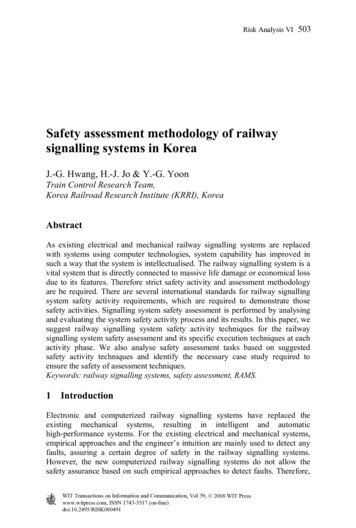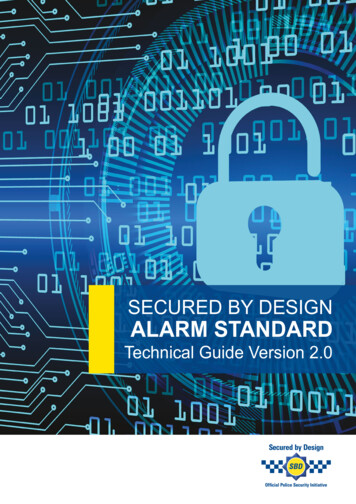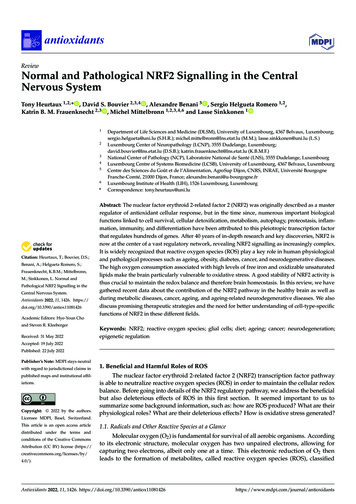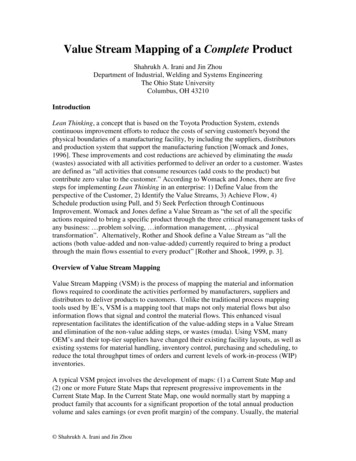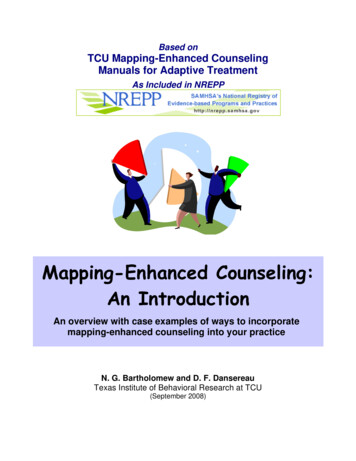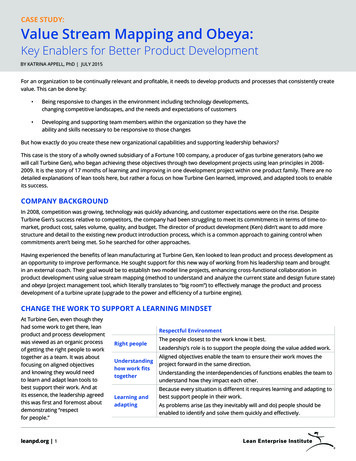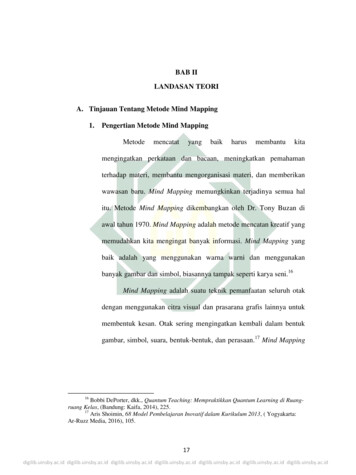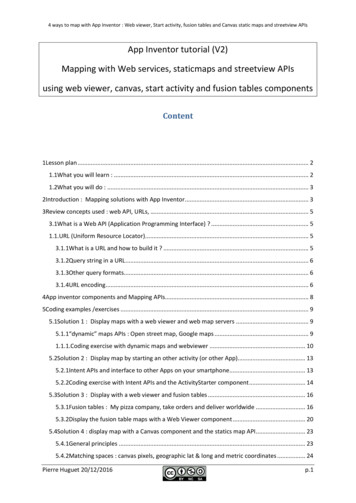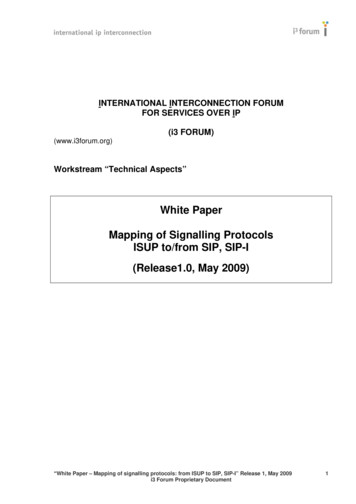
Transcription
INTERNATIONAL INTERCONNECTION FORUMFOR SERVICES OVER IP(i3 FORUM)(www.i3forum.org)Workstream “Technical Aspects”White PaperMapping of Signalling ProtocolsISUP to/from SIP, SIP-I(Release1.0, May 2009)“White Paper – Mapping of signalling protocols: from ISUP to SIP, SIP-I” Release 1, May 2009i3 Forum Proprietary Document1
Executive SummaryMapping between ISUP and SIP, or ISUP and SIP-I, is a complex area with regard to disconnect causevalues and this needs to be considered to ensure optimum behaviour for session control.The most straightforward case is ISUP to SIP-I in accordance with specification ITU Q1912.5, Annex CProfile C. Since the ISUP message is encapsulated within the SIP message, correct conveyance of theISUP information is guaranteed. Whereas, when ISUP has to be mapped into SIP there are a numberof standards that differ and this has led to different vendor implementations.A further level of complication exists when an ISUP to SIP conversion takes place in, for example, aService Provider domain and another ISUP to SIP/SIP-I conversion occurs in the International Carrierdomain. The level of end-to-end signalling transparency achieved depends on the compatibility of thetwo mapping activities. The more divergent these are, the less signalling transparency occurs.The objective of this document is to be informative, outlining to the carrier industry that inconsistenciesdo exist under some conditions and may lead to undesired network behaviour. Carriers need to take fullaccount of the complexities and ambiguities described in this paper when entering into bilateralcooperation for new SIP or SIP-I interconnections. It is expected that further work will be required toprovide greater clarity in the area of signalling interworking and, as a consequence, as soon as newstandards are available i3 Forum will be ready to endorse them and enhance the interconnection modeldocument.“White Paper – Mapping of signalling protocols: from ISUP to SIP, SIP-I” Release 1, May 2009i3 Forum Proprietary Document2
Table of ContentsExecutive Summary . 21Scope and Objective . 42Acronyms . 43References . 44Reference Configuration . 55Applicable International standards . 56Interworking Issues: ISUP-SIP, ISUP- SIP-I . 57Message mapping between ISUP – SIP and ISUP –SIP-I . 68Parameter Mapping Issues: ISUP-SIP, ISUP- SIP-I . 78.1Considerations on ISUP, SIP interworking . 78.2Considerations on ISUP, SIP-I interworking . 79Disconnect Cause Value Mapping . 79.1ISUP – SIP Interworking . 79.2ISUP – SIP-I Interworking . 810Conclusions and Recommendations . 911ANNEX 1 “Mapping from ISUP messages to SIP messages . 1012ANNEX 2 “Mapping from SIP Response Codes to ISUP Disconnect Cause Values” . 1113ANNEX 3 “Mapping from ISUP Disconnect Cause Values to SIP Response Codes . 13“White Paper – Mapping of signalling protocols: from ISUP to SIP, SIP-I” Release 1, May 2009i3 Forum Proprietary Document3
1Scope and ObjectiveThis document addresses signalling interworking issues when converting form TDM to IP. These issuesexist when inter-operating between legacy ISUP networks and next-generation VoIP networks usingSIP-based protocols.Mapping between ISUP and SIP, or ISUP and SIP-I, is a complex area with regard to disconnect causevalues and this needs to be considered to ensure optimum behaviour for session control.The objective of this document is to be informative, outlining to the carrier industry that inconsistenciesdo exist under some conditions and may lead to undesired network behaviour. Further work is neededin the standardization bodies and this has to be dealt with expeditiously.The content of this white paper is based on the i3 Forum document “Technical Interconnection modelfor International Voice Services”, Release 2, May 2009.2 -ITDM3Answer to Bid RatioAnswer Seizure RatioCall Detail RecordInternet Engineering Task ForceIntegrated Services Digital NetworkISDN User PartInternational Telecommunication UnionKey Performance IndicatorNetwork Efficiency RatioNetwork to Network InterfaceRequest for CommentsSession Initiation ProtocolSIP with encapsulated ISUPTime Division MultiplexingReferences[1] i3 Forum, “Technical Interconnection Model for International Voice Services”, Release 2.0, May2009[2] IETF RFC 3261 “SIP: Session Initiation Protocol”, June 2002[3] ITU-T Recommendation Q1912.5 “Interworking between Session Initiation Protocol and BearerIndependent Call Control or ISDN User Part”, 2004[4] IETF RFC 3398 – “ISUP to SIP Mapping”, December 2002[5] 3GPP TS 29.163 “Interworking between IP multimedia network and circuit switched networks,version 8.6.0, March 2009[6] ITU-T Recommendation Q.850 “Usage of codes and location in the digital subscriber SignallingSystem No. 1 and the Signalling System No. 7 ISDN User Part”, May 1998;[7] IETF RFC 3326 “The Reason Header Field for the Session Initiation Protocol (SIP)”, December2002;[8] ITU-T Recommendation Q.767. “Application of the ISDN User Part of CCITT Signaling System No.7 for International ISDN interconnections”;“White Paper – Mapping of signalling protocols: from ISUP to SIP, SIP-I” Release 1, May 2009i3 Forum Proprietary Document4
4Reference ConfigurationThe general reference configuration for international voice interconnection based on IP protocol is givenin [1] and endorsed in this document. Carriers operate switching facilities which are fed with TDM trafficas well as voice over IP traffic from the domestic fixed and mobile networks. The interconnectionbetween two Carriers makes use of signalling protocols and media flows carried onto an IP transportlayer.ServiceProvider AVoIPTDMCarrier ASIGNALLING(VoIP, Sigtran appls.)ServiceProvider BCarrier BMEDIACHFCHFBorderFunctionsBorderFunctionsSigtran Appls.TDMTransportSigtran Appls.TDMTDM(MNO)VoIP(MNO)CHF: Call Handling(DomesticOperator)(DomesticOperator)Figure 1 – General Reference Configuration5Applicable International standardsThis document assumes that international carriers handle interconnections using:a) IP-protocol interconnections utilising either SIP [2] or SIP-I [3], orb) TDM-protocol interconnections, based on international ITU-T White Book ISUP v1, v2 and v3,Note: as ITU- T White Book ISUP it is meant the collection of ITU-T recommendations which, in variousStudy Periods, have specified the ISUP protocol.It is accepted that other IP interconnection protocols exist but these are outside the scope of thisdocument and will not be addressed.With regard to the protocol interworking, including disconnect cause to response codes mapping, thefollowing standards apply:- RFC 3398 – “ISUP to SIP Mapping” [4]- ITU-T Rec. Q.1912.5 [3]- 3GPP TS 29.163 “Interworking between IP multimedia network and circuit switchednetworks” [5].All of these standards detail the mapping between the two protocol stacks applicable to IP and TDMnetworks. There are, however, significant differences between the mapping schemes as described inthis document.6Interworking Issues: ISUP-SIP, ISUP- SIP-IThere are a number of issues that need to be addressed when a session encounters protocolinterworking as it progresses through multiple carriersAs the protocol used to set-up the session is interworked, care must be given to:1) Messages mapping“White Paper – Mapping of signalling protocols: from ISUP to SIP, SIP-I” Release 1, May 2009i3 Forum Proprietary Document5
2) Parameter mapping3) Disconnect causes and response codes mappingA significant potential impact of having poor mapping between protocols would be a degraded serviceto client operators caused by incorrect behaviours such as: Loss of end-to-end service information needed to support services Automatic re-routing causes used by some carriers, based on one or several specificdisconnect causes. Typically, cause value 34 is used to reroute Accounting interchanged between clients and carriers based on cause values written toCDRs Voice KPI statistics and reporting, dependent on disconnect causes, for example, ASR,ABR, NER.If interworking is only performed once, two scenarios are possible:1 – Interworking is performed within the Service Provider domain. In this case, carriers only handleSIP/SIP-I traffic (see figure 2 below), mapping would therefore be the responsibility of the ServiceProvider.;2 – Interworking is performed by one of the carriers (see figure 3 below).This document focuses on the second scenario and the diagram shows this occurring at Carrier A.Interworking is performed in the Service Provider A network. Carrier A isunaware of ISUP - SIP mappingFigure 2- Interworking function locations, scenario 1Interworking is performed in the Carrier A network. Carrier A is responsiblefor ISUP - SIP mappingFigure 3- Interworking function locations, scenario 27Message mapping between ISUP – SIP and ISUP –SIP-ISignalling messages as well as their mandatory and optional parameters used in internationalinterconnect are listed in ITU-T Q.767 [8] “Application of the ISDN User Part in of CCITT SignallingSystem No. 7 for international ISDN interconnections”. The list contains 6 message groups1)2)3)4)Forward set-upGeneral SupervisionBackward SupervisionCall Supervision“White Paper – Mapping of signalling protocols: from ISUP to SIP, SIP-I” Release 1, May 2009i3 Forum Proprietary Document6
5) Circuit Supervision6) Circuit group supervisionThese 6 message groupings have, in total, 24 messages. In Annex 1, mapping of these messages toSIP, based on 3GPP TS 29.163 [5], can be found.From this table it can be seen that 11 messages are actually mapped to SIP methods and 13 are notmapped. It is necessary, therefore, to analyse the un-mapped messages to determine if they areindispensable for routing calls between TDM and SIP domains in both directions.The first three message groups, Forward set-up messages; Backward set-up messages; and Generalsupervision are fully mapped.The fourth group, Call supervision, is also mapped with the exception of the Forward Transfer (FOT)message which is for connecting an operator to assist in call set-up. This message is not essential forcall routing and its future use (if, indeed, it will be used), will depend on the operator applicationsrequirements, (for example, foreign language support) for VoIP international interconnects.In the fifth group, Circuit supervision, and sixth group, Circuit Group supervision, most of the messagesare not mapped to the SIP Method. However, in a VoIP domain, there are no actual circuits or circuitgroups, so therefore, circuit or circuit group supervision is unnecessary.88.1Parameter Mapping Issues: ISUP-SIP, ISUP- SIP-IConsiderations on ISUP, SIP interworkingIn ISUP/SIP interworking, information carried as parameters in the ISUP message header is mapped tothe SIP message. ISUP Information not mapped or inadequately mapped is lost.As an example, for end-to-end ISDN connections, since some of the ISUP parameters may not getmapped into the SIP messages,,. it is unclear what level of end-to-end capability can be provided overnative SIP interconnections. It is likely this level is variable and depends on the specific IETF RFCsimplemented in a given network.and thus end-to-end ISDN service cannot be guaranteed.8.2Considerations on ISUP, SIP-I interworkingMapping ISUP to/from SIP-I is a different case than mapping to/from native SIP since the ISUPmessages are encapsulated in the body of the SIP messages. As a result, the carrier conveys thesignalling information transparently by using the encapsulation mechanism. The receiving network canextract the full ISUP message from the body of the SIP message.This encapsulation will ensure the integrity of ISUP parameters and disconnect cause informationbetween service providers.In this case, for example of end-to-end ISDN connections, since the ISUP parameters are mapped intothe SIP messages, end-to-end ISDN service is guaranteed provided that the appropriate bearercapabilities are supported.99.1Disconnect Cause Value MappingISUP – SIP InterworkingIn ISUP, the disconnect cause values contained in the release message are defined in ITU standardQ.850 [6]and are in the range 1 to 127.“White Paper – Mapping of signalling protocols: from ISUP to SIP, SIP-I” Release 1, May 2009i3 Forum Proprietary Document7
In SIP, the equivalent to ISUP disconnect cause values are error response codes and are in the range4xx, 5xx, and 6xx. There is no one-to-one mapping for each TDM cause into SIP protocol error codes.Consequently, mapping between protocols therefore inevitably leads to loss of cause granularity aspreviously described.In a call flow where the origination and termination are both ISUP and the Carrier-Carrier interconnect isbased on SIP, the disconnect cause information will get mapped from ISUP to SIP error response codeand then back to an ISUP disconnect cause in the next interworking. The end-to-end disconnect causetransparency will be degraded between the two Service Provider networks. Refer to section 7 for moredetails.In practice this means that it is possible for a cause value sent from the terminating ISUP node to theoriginating ISUP node to be changed by the interworking function and the value received will, therefore,be different from that originally returned from the terminating node.In Annex 2 the mapping from SIP error response codes to ISUP disconnect cause values, according toboth [3] and [4] is given. Annex 3 gives the mapping of the ISUP disconnect cause values to SIP errorresponse codes according to the same two specifications.An example of mishandling of disconnect cause is:Example 1: Call ISUP- SIP- ISUP: Using RFC 3398 mappingISUP (REL): 2 – “No route to network” - SIP (code): 404 - “Not found” - “Unallocated/unassigned number”ISUP (REL) 1-Example 2: Call ISUP- SIP- ISUP: Using Q.1912.5 mappingISUP (REL): 2 – “No route to network” - SIP (code): 500 - “Server internal error” - ISUP (REL) 127“Interworking unspecified”In both examples the original cause is REL 2 sent out from the terminating side, but what thebackwards carrier received is REL 1, following RFC3398, or REL 127, following Q.1912.5.Neither of the two standard defined mappings is preserving the original REL value.As a possible solution, the use of the Reason header in accordance with IETF RFC 3326 [7] isrecommended to enable the inclusion of the ISUP disconnect cause codes.According to [7], “It is normally present in BYE and CANCEL messages but it may be included in anyrequest within a dialog, in any CANCEL request and in any response whose status code explicitlyallows the presence of this header field.”Note, however, that according to RFC 3326, clients and servers are free to ignore this header field. Ithas no impact on protocol processing or rerouting in most applicable network elements, as it is onlyaccepted as additional information.It can be concluded from the above extract from RFC3326 that the actual interoperability behaviourbetween nodes may differ depending on the implementation of such functionality by the respectivevendors.9.2ISUP – SIP-I InterworkingThe issues described in the previous section are at the SIP level also relevant in the SIP-I – ISUPinterworking scenario.In the case of SIP-I, however, although the SIP messages handled by carriers will still contain the SIPstatus code values, the actual ISUP disconnect cause values are preserved and encapsulated in themessage body.“White Paper – Mapping of signalling protocols: from ISUP to SIP, SIP-I” Release 1, May 2009i3 Forum Proprietary Document8
When there is a difference of significance between the SIP Error code and the ISUP disconnect causevalue in SIP-I, the ISUP disconnect cause always takes precedence.This interworking case is not as complex as interworking via native SIP, since many network elements,even though they do not read the content of ISUP messages, can read and act on the Release field. Incase of different criteria, according to ITU-T Q.1912.5 [3], the ISUP value takes precedence over theSIP value.Note that some vendors may not be compliant to this ITU standard implementation. Consequently,incorrect operation and failure reason reporting could occur.10 Conclusions and RecommendationsAs far as message mapping is concerned, the analysis indicates that a complete an unambiguousmapping exists between ISUP and SIP messages. The only exception, the Forward Transfer message,does not pose a major problem since it is rarely used.Regarding parameter mapping the use of SIP-I guarantees transparency. Care should be taken, whenSIP is used, to ensure implementation supports required capabilities. Specifically, if full ISDN supporthas to be guaranteed then SIP-I has to be used.From the perspective of disconnect cause value mapping, there is no one-to-one mapping for eachTDM cause into SIP protocol error codes. Consequently, mapping between protocols thereforeinevitably leads to loss of cause granularity as previously described. In addition, though three standardsare available, these standards are not consistent with each other. This issue can be solved by using theReason Header as already recommended by ITU-T but the usage of such mechanism should berequired and vendors have to design equipment accordingly.As far as the use of SIP-I is concerned, the transparency of the disconnect cause value is guaranteedby the encapsulation of the ISUP message into the SIP body.The objective of this document is to be informative, outlining to the carrier industry that inconsistenciesdo exist under some conditions and may lead to undesired network behaviour. Carriers need to take fullaccount of the complexities and ambiguities described in this paper when entering into bilateralcooperation for new SIP or SIP-I interconnections. It is expected that further work will be required toprovide greater clarity in the area of signalling interworking and, as a consequence, as soon as newstandards are available i3 Forum will be ready to endorse them and enhance the interconnection modeldocument [1].“White Paper – Mapping of signalling protocols: from ISUP to SIP, SIP-I” Release 1, May 2009i3 Forum Proprietary Document9
11 ANNEX 1 “Mapping from ISUP messages to SIP messages#1IAMSAMCOTISUP MESSAGEInitial addressSubsequent addressContinuityACMAddress completeCONCPGConnectCall Progress (alerting)ANMFOTRELRLCCCRRSCAnswerForward transferReleaseRelease completeContinuity check requestReset circuit131415BLOUBLBLA16UBA171819SUSRESCircuit Group ementUnblockingacknowledgementSuspendResumeCircuit group pervision202122CGUCGBACGUA23GRSCircuit group unblockingCircuit group blocking ack.Circuit group unblockingack.Circuit group reset24GRACircuit group reset ack.SIP MESSAGEINVITEcollecting address - INVITE(success) SDP indicating preconditions met. UPDATE180 RINGING or183 SESSION PROGRESS200 OK (INVITE)180 RINGING or183 SESSION PROGRESS200 OK (INVITE)No EquivalentBYE, CANCELNo EquivalentNo Equivalent200 OK - BYE200 OK - 480 TemporarilyUnavailableCANCELNo EquivalentNo EquivalentNo EquivalentNo EquivalentNo EquivalentNo Equivalent200 OK - BYE200 OK - 480 TemporarilyUnavailableCANCELNo EquivalentNo EquivalentNo Equivalent200 OK - BYE200 OK - 480 TemporarilyUnavailableCANCELNo Equivalent“White Paper – Mapping of signalling protocols: from ISUP to SIP, SIP-I” Release 1, May 2009i3 Forum Proprietary Document10
12 ANNEX 2 “Mapping from SIP Response Codes to ISUP Disconnect CauseValues”The yellow rows indicate a mismatch between the IETF RFC 3398 and ITU-T Rec. Q.1912.54xx, 5xx, 6xx on INVITEError Response CodeREL (Cause Value) ISUP(Follows IETF RFC 3398)Cause ValueREL (Cause Value) ISUP(Follows ITU-Q.1912.5)Cause Value400 Bad Request41("Temporary Failure")127 ("Interworking unspecified")401 Unauthorized21("Call rejected")127 ("Interworking unspecified")402 Payment Required21("Call rejected")127 ("Interworking unspecified")403 Forbidden21("Call rejected")127 ("Interworking unspecified")404 Not Found1("unallocated(unassigned) number)405 Method Not Allowed63127 ("Interworking unspecified")406 Not Acceptable79407 Proxy authentication required21("Service option notavailable,unspecified")(Classdefault)("Service option notimplemented,unspecified")("Call rejected")408 Request Timeout102("Recover on Expirestimeout")127 ("Interworking unspecified")410 Gone22("Number changed(without diagnostic)")22413 Request Entity too long127127 ("Interworking unspecified")414 Request-uri too long127415 Unsupported Media pecified")("Service option notimplemented, unspecified416 Unsupported URI scheme127127 ("Interworking unspecified")420 Bad Extension127421 Extension required127423 Interval Too Brief127480 Temporarily rworkingunspecified") (Classdefault)("no user responding")481 Call/Transaction does not exist41("Temporary Failure")127 ("Interworking unspecified")482 Loop Detected25127 ("Interworking unspecified")483 Too many hops25484 Address Incomplete28("Exchange routingerror")("Exchange routingerror")("Invalid number format(address incomplete) ")485 Ambiguous1("Unallocated(unassigned) number")127 ("Interworking unspecified")486 Busy Here17("User busy")487 Request terminated488 Not acceptable here1("unallocated (unassigned)number)127 ("Interworking unspecified")127 ("Interworking unspecified")("Number changed (withoutdiagnostic)")127 ("Interworking unspecified")127 ("Interworking unspecified")127 ("Interworking unspecified")127 ("Interworking unspecified")127 ("Interworking unspecified")20("Subscriber absent")127 ("Interworking unspecified")2817("Invalid Number format(addressincomplete)")("User busy")127 Interworking or no mapping127 ("Interworking unspecified")491 Request Pendingno mapping493 Undecipherable127 ("Interworking unspecified")500 Server Internal error41("Temporary failure")127 ("Interworking unspecified")501 Not implemented79("Service or option notimplemented,unspecified")127 ("Interworking unspecified")“White Paper – Mapping of signalling protocols: from ISUP to SIP, SIP-I” Release 1, May 2009i3 Forum Proprietary Document11
502 Bad Gateway38("Network out of order")127 ("Interworking unspecified")503 Service Unavailable41("Temporary failure")127 ("Interworking unspecified")504 Server timeout102127 ("Interworking unspecified")505 Version not supported127513 Message too large127("Recovery on rking,unspecified")580 Precondition failure127 ("Interworking unspecified")127 ("Interworking unspecified")127 ("Interworking unspecified")600 Busy Everywhere17("User busy")17("User busy")603 Decline21("Call rejected")21("Call rejected")604 Does not exist anywhere1("Unallocated(unassigned) number")1("Unallocated number")606 Not acceptable127 ("Interworking unspecified")“White Paper – Mapping of signalling protocols: from ISUP to SIP, SIP-I” Release 1, May 2009i3 Forum Proprietary Document12
13 ANNEX 3 “Mapping from ISUP Disconnect Cause Values to SIP ResponseCodesThe yellow rows indicate a mismatch between the IETF RFC 3398 and ITU-T Rec. Q.1912.5REL ISUP-Cause Disconnect Values -SIP Message(Follows IETF RFC 3398)SIP Message(Follows ITU-Q.1912.5)1("Unallocated (unassigned) number")404Not found404 Not Found2("No route to network")404Not found500 Server Internal Error3("No route to destination")404Not found500 Server Internal Error4("Send special information tone")500 Server Internal Error5("Misdialled trunk prefix")17("User busy")486Busy here486 Busy Here404 Not Found18("No user response")408480 Temporarily unavailable19("No answer from the user")48020("Subscriber absent")480Request e21("Call rejected")22("Number changed")403410301ForbiddenGone orMoved Permanently410 Gone23("Redirection to new destination")410GoneNo interwork25("Exchange routing error")26("Non-selected user clearing")404Not found27502Bad Gateway502 Bad Gateway28("Destination out of order")("Invalid number format (addressincomplete)"484Address incomplete484 Address Incomplete29("Facility rejected")501500 Server Internal Error31("Normal, unspecified") (Class default)480Not implementedTemporarilyunavailable480 Temporarily unavailable480 Temporarily unavailable480 Temporarily unavailable480 Temporarily unavailableCause Value in the Class 010 (resourceunavailable Cause Value No. 34)503 Service unavailable480 Temporarily unavailable486 Busy here if Diagnostics Indicatorincludes the CCBS indicator38("Network out of order")503Service unavailable41("Temporary failure")503Service unavailable500 Server Internal ErrorService unavailable500 Server Internal Error44("Switching equipment congestion")("Requested circuit/channel notavailable")50346("Precedence call blocked")4247 ("Resource unavailable, unspecified")Cause Value in the Class 010 (recourceunavailable Cause Value No. 38, 41-44,46,47)(47 is class default)50("Requested facility not subscribed")("Incoming class barred within ClosedUser Group (CUG)")500 Server Internal Error500 Server Internal Error500 Server Internal Error503Service unavailable500 Server Internal Error500 Server Internal Error500 Server Internal Error403Forbidden500 Server Internal Error403Forbidden500 Server Internal Error503Service unavailable500 Server Internal Error63("Bearer capability not authorized")("Bearer capability not presentlyavailable")("Service option notavailable,unspecified") (Class default)65("Bearer capability not implemented")488Not acceptable here500 Server Internal Error555758500 Server Internal Error6669500 Server Internal Error79500 Server Internal Error(Requested Facility not implemented)70("Service option notavailable,unspecified")488Not acceptable here500 Server Internal Error501Not implemented500 Server Internal Error“White Paper – Mapping of signalling protocols: from ISUP to SIP, SIP-I” Release 1, May 2009i3 Forum Proprietary Document13
Cause Value in the Class 100 (Service oroption not implemented, Cause Value No. 65,66,69,70,79) (79 is class default)("User not member of Closed User87 Group(CUG)")500 Server Internal Error403Forbidden500 Server Internal Error503Service unavailable500 Server Internal Error88("Incompatible destination")90("Non existent CUG")500 Server Internal Error91("Invalid transit network")404 Not Found95500 Server Internal Error97("Invalid message (Class default)")("Message type non-existent or notimplemented")99("Information element/parameter nonexistent or not implemented")102("Recover on Expires timeout")103110111127("Parameter non-existent or notimplemented, passed on")("Message with unrecognizedparameter, discarded")("Protocol error unspecified") (Classdefault)("Interworking, unspecified") (Classdefault)500 Server Internal Error500 Server Internal Error504Server Timeout480 Temporarily unavailable500 Server Internal Error500 Server Internal Error500Internal Server Error500 Server Internal Error500Internal Server Error480 Temporarily unavailable“White Paper – Mapping of signalling protocols: from ISUP to SIP, SIP-I” Release 1, May 2009i3 Forum Proprietary Document14
A further level of complication exists when an ISUP to SIP conversion takes place in, for example, a Service Provider domain and another ISUP to SIP/SIP-I conversion occurs in the International Carrier domain. The level of end-to-end signalling transparency achieved depends on the compatibility of the two mapping activities.


